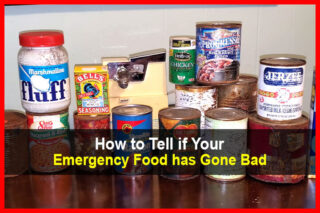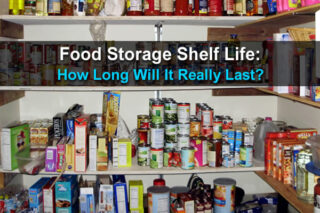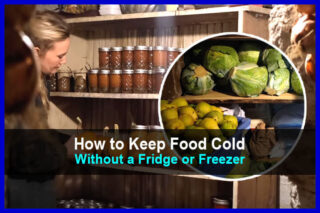Estimated reading time: 16 minutes
Whether you buy your fruits or vegetables at the grocery store or grow your own we’ve all learned the hard way that some fruits and vegetables don’t last long without refrigeration.
Then again, some fruits and vegetables like tomatoes and bananas are better when stored without refrigeration. We’ll cover the specifics of what to refrigerate and what not to refrigerate but there’s a bigger question.
Want to save this post for later? Click Here to Pin It On Pinterest!
What Do You Do Without a Refrigerator?
It’s hard for a lot of us to imagine life without a refrigerator but it happens. Long-term power outages measured in days or even weeks are one example. Some of us choose to pursue an off-grid lifestyle and have no doubt found numerous solutions. There are also occasions when we might be camping or in some other situation where there’s either no electricity or a refrigerator is unavailable.
It’s a times like these when it helps to know how to find or improvise a solution. There are also times when we grow our own vegetables and find ourselves overwhelmed by a such large harvest that we can’t even give it away.
Understanding the Science of Food Freshness
Fruits and vegetables that require refrigeration are subject to a few adverse effects when not refrigerated. This sometimes happen in stages and in some instances, simultaneously. Here are the typical stages of spoilage that occur with fruits and vegetables that are not refrigerated.
Wilting
Wilting commonly occurs with green, leafy vegetables like lettuce, kale, spinach and other leafy greens. It can also occur with celery, bok choy, carrots and others as well. Even in the refrigerator vegetables have a shelf-life but refrigeration helps to extend the freshness of anything you pick or buy.
Mold
Mold can happen with any type of food but it’s very common with fruits. The natural sugars in the fruits often lend themselves to mold growth, and their exposure to all things drifting in the wind can leave some active spores on their surface waiting to grow into mold.
Ironically it was a mold growth on an orange that led to the invention of penicillin, but typically mold on any fruit it not worth eating. Here again, refrigeration is no guarantee but it can delay the appearance of mold.
Contamination
Bacteria and viruses are another concern and while refrigeration won’t guarantee sterile or sanitary vegetables and fruits, it can at least inhibit or slow their growth. Washing fruits and vegetables even after refrigeration is always wise mostly to rinse off any pesticides, but you’ll rinse away some germs as well. We’ll cover a vinegar technique later that works best.
Decomposition
All fruits and vegetables eventually rot. Compost heaps depend on it. Cold temperatures delay that process.
Fruits and Vegetables that DON'T Require Refrigeration
Some fruits and vegetables actually stay fresher longer at room temperature. Others simply don’t require refrigeration including:
- All berries
- All Potatoes
- Apples
- Avocados
- Bananas
- Bell peppers
- Citrus fruits like mandarin oranges, lemons and limes
- Cucumbers
- Garlic
- Kiwis
- Mangoes
- Melons including watermelon and honeydew melons
- Onions
- Pears
- Persimmons
- Pineapples
- Stone fruit like apricots, plums, peaches
- Tomatoes
- Winter Squash like acorn, butternut, spaghetti squash
But don’t get cocky. Just because some fruits and vegetables don’t require refrigeration that doesn’t mean they’re indestructible. All fresh fruits and vegetables have a relatively short shelf-life.
They’re all best if eaten in a week or two. Refrigeration can extend that time in some cases but if they don’t need refrigeration you should save the room for those fruits and vegetables that actually do.
Fruits and Vegetables that DO Require Refrigeration
You may have noticed some of the effects of a lack of refrigeration on some fruits and vegetables. Think wilted lettuce, limp carrots and celery, or soft broccoli. This is inevitable even with refrigeration but keeping some fruits and vegetables cool will keep them fresh and crisp longer.
Here are some candidates for refrigeration:
- Asparagus
- Beans
- Beets
- Bok Choy
- Broccoli
- Brussels Sprouts
- Cabbage
- Carrots
- Cauliflower
- Celery
- Cherries
- Cranberries
- Eggplant
- Fennel
- Grapefruit
- Grapes
- Leafy Greens
- Leeks
- Mushrooms
- Okra
- Peas
- Rhubarb
- Root Vegetables (Turnips, Rutabagas, Parsnips)
- Spinach
- Summer Squash/Zucchini
These are the fruits and vegetables that fail at room temperature and are best kept cold.
4 Factors That Keep Fruits and Vegetables Fresh
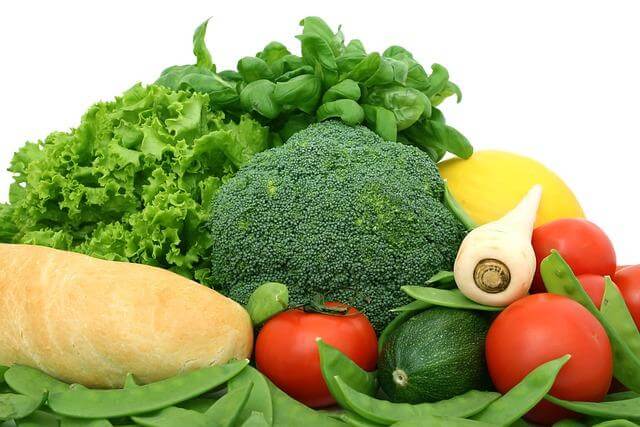
There’s more to keeping foods like fruits and vegetables fresh than just refrigeration. The crisper drawer in a refrigerator adds humidity to the equation, and the ethylene gas given off by some fruits like bananas actually accelerate ripening and decomposition. Here’s the science behind those factors and possible solutions.
Temperature
The ideal temperature for vegetables and fruits requiring refrigeration is a range of 35 to 55 degrees Fahrenheit. It may be hard to get to those temperatures let alone maintain them consistently with an improvised refrigerator, but if you can get close it helps.
Refrigerators make it easy to select the proper temperature and the two drawers in a refrigerator are typically designed to store fruits in one drawer and vegetables in the other drawer. A slide at the top of the drawer helps manage the humidity level in the drawer. But even then, some fruits and vegetables should be separated. The reason they should be separated has to do with the next two factors.
Humidity
Vegetables prefer humidity more than most fruits. That’s why that’s why it’s important to remember that sliding slot on a crisper drawer to allow you to hold in humidity or release it.
The ideal humidity for fruits and vegetables is in a range of 80 to 95%. This helps to keep them moist and reduce transpiration. Humidity is often easier with some improvised systems especially with root cellars or any cooling designs that use water to reduce temperatures.
In actual fact we don’t always manage those ideal humidity levels even in a refrigerator. What’s important to remember is that if you are improvising a food storage solution to keep fruits and vegetables fresh, it helps to think about how you can find or add humidity to the environment.
Chemistry
Many fruits and vegetables give off various gases as they are stored, ripen and eventually decompose. Often, the aroma of a fruit or vegetable is the result of this chemical element in the form of gas.
Over time, the aroma increases and even changes as the fruit continues to ripen and then rot. Bananas are a prime example and the ethylene gas from a banana is not only noticeable but will accelerate the ripening and decomposition of many fruits and vegetables surrounding them.
In fact, some bananas are sold in a bunch with tape over the ends of the stems. This is where most of the ethylene from a banana is released and the tape slows down the amount of ethylene released to the surrounding air.
This is also why you often see banana stands designed for a countertop. The idea is to keep the bananas up, out and away from the fruit basket with other fruits, and to isolate them away from the surrounding fruits.
But it goes beyond bananas. Other fruits and vegetables that exude gases that can adversely affect surrounding fruits and vegetables include:
- Apples
- Avocados
- Cantaloupe
- Pineapples
- Tomatoes
Light
Sunlight can not only raise the temperature of a fruit or vegetable but the surrounding air as well. The UV rays can also cause fruits and vegetables to decompose more rapidly although UV light does a good job of killing germs at least on those surfaces exposed.
Regardless, sunlight should be avoided when storing fruits and vegetables. This typically takes care of itself in any kind of storage but a fruit bowl on a countertop should not be near a south-facing window.
As we explore alternative ways to keep fruits and vegetables fresh we’ll mention when these factors are important and how to implement or manage them.
Various Approaches to Maintaining Freshness
A quick look at history can teach us a lot of lessons about how to keep fruits and vegetables fresh. Long before electricity and the technology of refrigeration every person on the planet eventually figured out ways to keep things cool from their food to themselves.
The great thing about many of these “old” ideas is that they’re fairly easy to implement across a variety of areas and conditions. Throughout the article we’ll feature links to articles that demonstrate how to improvise these cooling and storage solutions in more detail.
1. The Zeer Pot
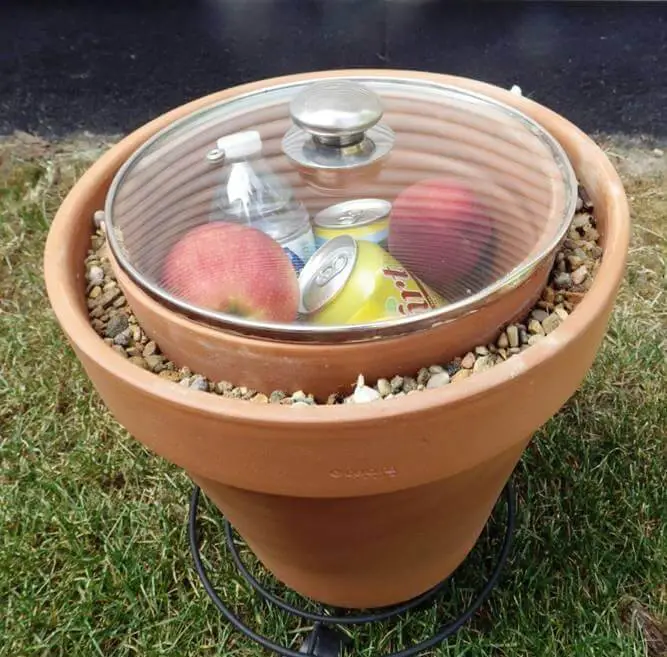
The Zeer pot is an invention often attributed to the ancient Egyptians. It’s used to this day particularly in Africa and its construction is as simple as using two terra cot clay pots and some sand and water. The ideal location was a shady spot exposed to prevailing winds.
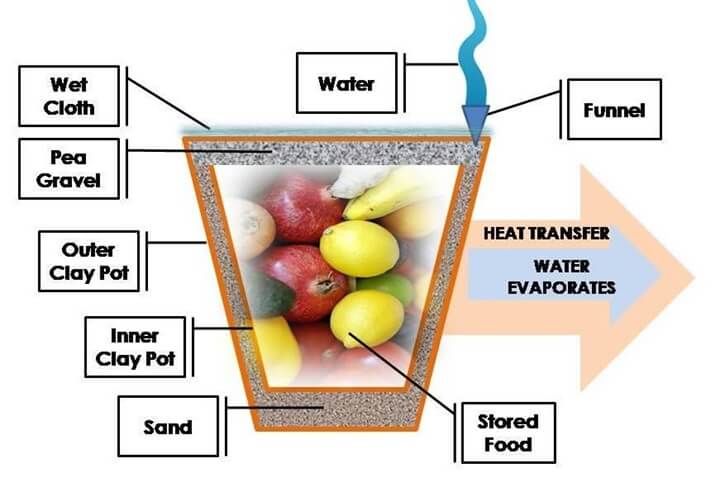
The Zeer pot uses evaporative cooling to keep the interior of the clay pots cooler than the outside air. The end benefit was a cool and moist environment in a portable pot that could be built and taken anywhere.
2. The Root Cellar

Pioneers and homesteaders around the world used the naturally cool effect of the ground to design and build underground rooms commonly referred to as a root cellar. The cellars were often lined with shelves to hold fruits, vegetables and even preserved foods in jars and cans.
The floor was usually bare ground to allow the natural humidity in the ground to humidify the cellar while keeping the temperatures cool.
3. Mini Root Cellars
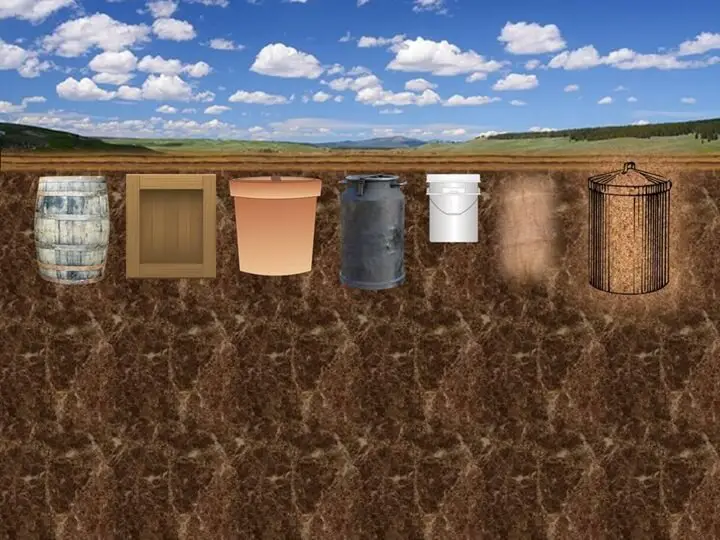
Many cultures figured out that you didn’t need to dig a large room or cellar in the ground to keep foods cool. Even a hole in the ground lined with burlap will keep foods cooler than temperatures above ground.
There are many variations on how to line or create one of these mini root cellars from burying barrels to garbage cans to 5-gallon plastic buckets.
4. Your Basement
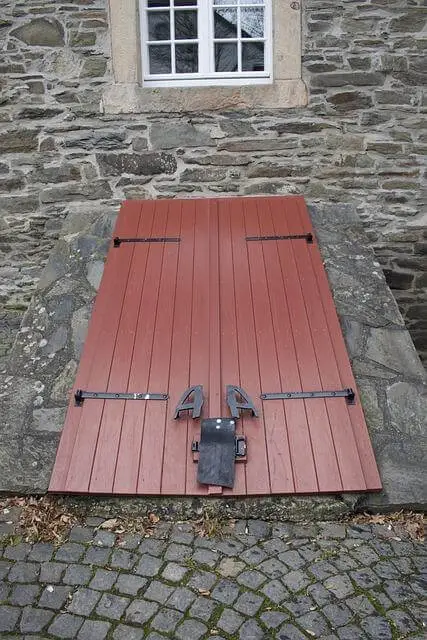
Many of us notice a difference in temperature anytime we head down to the basement. What we’re feeling is the natural effects common in any root cellar. The surrounding ground and the typical moisture in most basements make for a good storage space for fruits and vegetables.
It’s a bit of a hassle to store everything in the basement but if you have no kitchen solutions it will keep vegetables and fruits fresher for a longer period of time.
5. The Ice Box
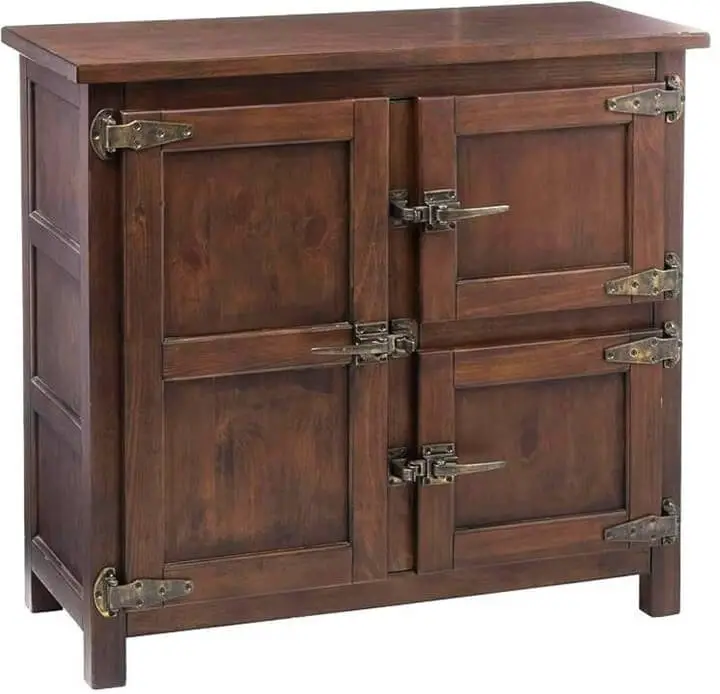
The ice box was once considered a modern luxury. It was basically an insulated box approximating the size and shape of a refrigerator. The difference was that it was not powered by electricity. Large blocks of ice were placed on a wide top shelf and the melt water was drained into a pan at the bottom of the ice box.
The ice block lasted anywhere from a couple of days or a week or more depending on the size of the ice block and the surrounding temperature.
6. The Cold Pantry
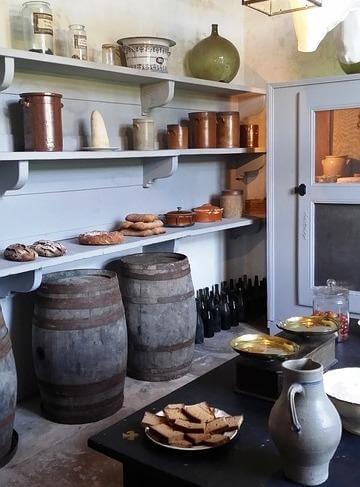
A small room or pantry with a window was often used to store fruits and vegetables. The window could be opened to let both colder air inside and to provide some air circulation. It didn’t work in the middle of summer but if the summer nights were cool it could still help.
7. Hanging or Braiding
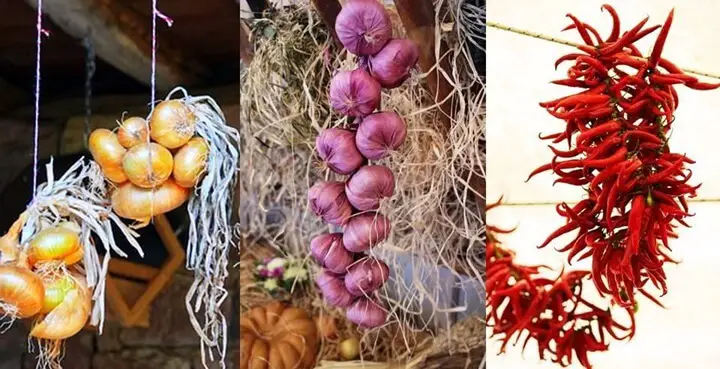
A common practice with some vegetables is to braid them into long braids and hang them from rafters or on hooks. Onions and garlic were often stored this way and even hot peppers were strung on long strings. And it wasn’t just about exposing them to any circulating air. Onions and garlic are one of those vegetables that emits a gas that affects other vegetables and fruits.
They can cause other vegetables and fruits to ripen and rot quickly. Braiding allowed the onions and garlic to be stored separate from other fruits and vegetables. A back porch was often a location of choice but even attics or other spaces with rafters or exposed beams for hanging the braids.
This made it particularly easy to store onions away from potatoes. Onions next to potatoes will cause the potatoes to soften and sprout eyes.
8. Wells
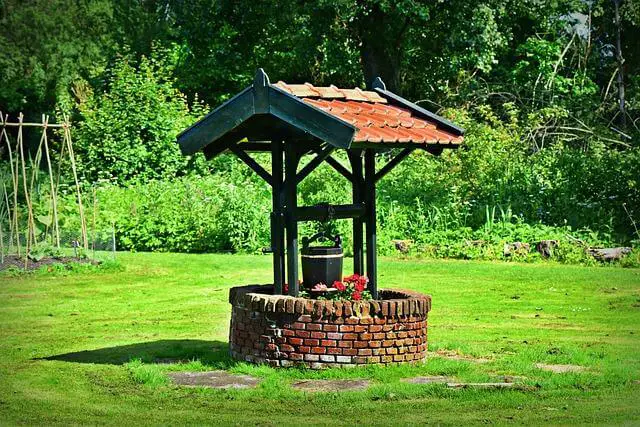
Open wells were often used to keep fruits and vegetables fresh. They were often enclosed in a mesh or burlap bag and carefully lowered into the well. The colder water temperature helped keep them fresh.
9. Earth Air Tunnel Cooling
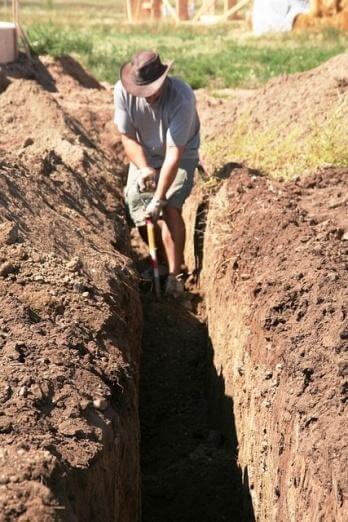
This is another primitive and ancient cooling technique. It involves digging a trench deep into the ground leading to a small shed.
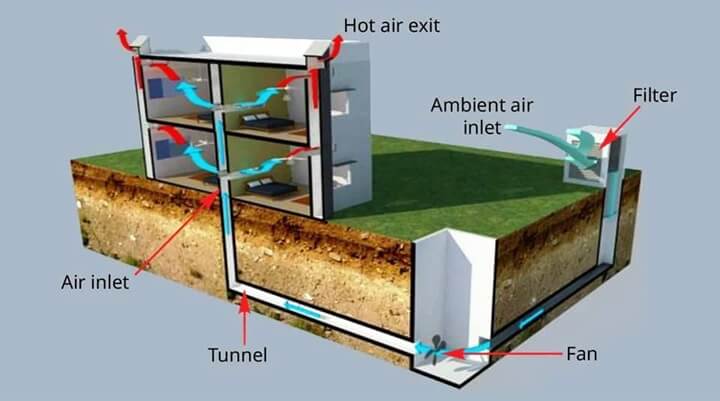
The trench is covered with branches, thatch and soil and the cooler ground temperatures chill the air leading to the shed or home.
10. Spring Creeks

The cold water of a spring creek is a non-stop chilling machine. Pioneers would immerse a large metal box into the bed of the creek. The metal box was watertight and had a locking lid. Anything they wanted to keep cold was placed into the box including fruits and vegetables.
Some General Storage Tips
The Ethylene Effect
Many fruits and vegetables release ethylene gas as they ripen. The effect is to cause other surrounding fruits and vegetables to ripen as well. Here are some of the more popular fruits and vegetables that release ethylene:
- Apples
- Avocados
- Bananas
- Cantaloupe
- Tomatoes
Regardless of how you keep your fruits and vegetables cold, you should avoid storing any of these fruits and vegetables in close proximity to any other fruit or vegetable. They seem to enjoy their own company without complaint but they don’t get along well with others.
In fact, if you want to accelerate the ripening of any fruit or vegetable, just put some bananas on top of them in a fruit bowl and everything will speed up.
Complicating everything is that some varieties of the above vegetables produce more ethylene and some less. That’s why in addition to keeping ethylene producing fruits and vegetables separate, it helps to make sure there is adequate ventilation or some degree of air circulation when possible.
You could also buy ethylene absorbers that reduce the amount of ethylene released into the surrounding air. They can be used in an improvised cooling system or even in a fruit bowl on the counter. This may be the only foolproof way to manage rapid ripening due to ethylene.
Ethylene’s not all bad. Many fruits and vegetables are harvested and shipped before ripening to survive their time in transit. The ethylene will actually help the fruits to ripen once you get them home. Just make sure you keep an eye on that fruit bowl.
The Vinegar Treatment
It’s surprising if not disappointing how contaminated by bacteria so many fruits and vegetables are. This is especially true for any fruit or vegetable that grows low to the ground where animal droppings can lead to e coli, listeria and salmonella. This can not only lead to serious food-borne illnesses, but can accelerate the deterioration and decomposition of fruits and vegetables.
Our correct instinct is to wash them before we eat them but that’s usually a quick rinse under water. That helps but wiping or soaking them in a water/vinegar solution is a giant step better. A proportion of 1 part vinegar to 3 parts water is a good place to start.
Vinegar is a powerful antiseptic and it’s safe to eat. An additional rinse under running water will remove any residual vinegar and any fruits or vegetables that go into storage will be at their pristine best.
The fruit or vegetable can then be placed in a sealable plastic bag while still moist. Don’t dry them off. This will help maintain some moisture and the bag will help keep them separated in some of the improvised cooling designs we covered.
When All Else Fails
Some of us get overwhelmed especially at harvest season. Then again there are times where nothing we try seems to work to keep fruits and vegetables fresh. The best solution when all else fails is to turn to traditional food preservation techniques like canning, fermenting, curing or dehydrating.
In the grand scheme of things many fruits and vegetables will do just fine in a fruit basket on the counter –at least for a while. If you want to extend their shelf-life and can’t refrigerate some of these alternatives can not only work but become the new way to always eat fresh.
Like this post? Don't Forget to Pin It On Pinterest!
You May Also Like:







